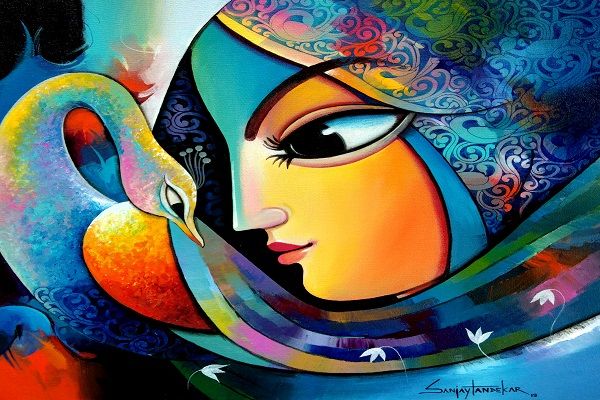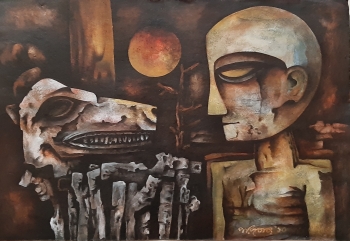
“You leave me with no choice but to declare you excommunicado”
----Winston, John Wick-2
As a child, growing in a small town came with its perk and privileges. There were no shopping complexes or apps where you could find groceries, clothes, accessories, and even paintings online. The landscape was not filled with skyscrapers but two-story houses having trees and big porches where morning tea was served with maiden rays of the sun descending.
The art and culture here have the propensity of showing themselves off by different mediums. Dull and trodden public spaces lit up upon the arrival of the much-awaited annual exhibition in the month of March. The streets came alive with vivacious and quirky one-liners advertising the ‘Maut ka Kuan’, ‘Appollo Circus’, and a makeshift amusement park.
Painting on the street of walls is the most coveted form of marketing strategy in these areas where the rural populace is in dominance. Generally, the walls of the street are seen to be embellished with the advertisements by quacks claiming to have the ‘Achook Ilaaj’ of the diseases relating to your nether regions (if you got what I meant).
But, urbanized street art is an altogether different concept. Although painting walls and roads with colored excreta of the mouth while walking has been in our 'culture' ever since but for reasons best known to historians, the birth of street art or Graffiti is ascribed to ancient Rome and Greece.
If the Abovementioned Examples are not Graffiti, then What is?
Etymologically, the word graffiti comes from the plural form of the Italian word ‘Graffito’. It translates to scratch in English. An art to become graffiti must be created, drawn, inscribed, sprayed, or painted on public roads and walls of public buildings such as underpass, metro stations, parks, etc.
Legally, this act would amount to vandalism and may attract a penal action against the person who is caught committing that. There is an unspoken covenant that they would never reveal they are a true identity- they have been banished and excommunicado.
It may not be necessarily a painting or drawing. A calligraphic slogan written in any language or font amounts to graffiti. For this reason, graffiti artists are known as ‘Graffiti Writers’ and their signatures as ‘Tags’.
The purpose behind this act is to demand attention or register dissonance against prevailing socio-political conditions in the surroundings. All forms of art like music, movies, plays, novels, paintings, slogans, etc. have always played a part in overwhelming ‘Volkgeist’ with emotions. Graffiti depicting, provoking and rebellious ideas, do the same.
The Rise of Graffiti
Earlier forms of graffiti could be seen in the ruins of Rome, Greece and Mayan sites. But, the lightening of popularity struck it in the late 1960s in America through politically-charged groups and ideologically motivated gangs.
However, modern graffiti owes its glorification to Philadelphian Cornbread who was housed by Philadelphia’s Youth Development Center or YDC in the year 1965 when he was 12, his real moniker being Darryl McCray. He liked cornbread so much that cooks of the facility gave this nickname to him. Later, he grouped with Cool Earl and Kool Klepto Kid to swamp the streets of Philadelphia with their art.
Tags of the century!
Taki 183
He is contemporary of Cornbread in New York City. Taki is an alias of Demetrius, his christened name and 183 signifies the 183rd street from the Greek locality of Washington Heights. It was a phase when American kids were believed to have lost the sense of purpose and they found one in Street art. Taki 183 was one of them who found his interest in painting his name across the walls of the street he visited frequently getting inspired by JULIO 204.
JULIO 204
JULIO 204, a Puerto Rican, was one of the first graffiti writers of New York who dwelled in the 204th street in the Inwood Neighborhood of Manhattan. Although he inspired many graffiti artists who eventually rose to fame, his arrest in the summers of 1970s stopped his career. He was a member of Felipe Mercado’s Savage Skulls who were famous for waging war against drug abuse in their locality.
Graffiti in India
Graffiti around the world was a way of expressing anger and frustration of the neglected youth. As a consequence, it met with severe criticism and non-acceptance. But, graffiti displaying Indian paintings is welcomed by society. What makes it worse is the consent. If you have that- Bingo.
The Curious Case of Khirkee Village
Finding a person who could willingly let the artists paint his wall is easy. All the artists have to do is to ensure the owner that his art would increase the beauty of their place manifold. The artists would paint the walls for free and that too beautifully, what else would one want. They are less possessive about things like trespassing!
Semi-urban areas and outskirts of cities are best for artists to find an owner or even a volunteer. Khirkee Village, situated on the outskirts of Delhi is one such example. The walls of the houses in this village have become an all-time canvas for street artists from India and abroad. A masked Buddha with green vines emerging out is painted by artist Yantr against the wall of a garbage dumping place. He made it to mark the success of Operation Smiling Buddha- India’s first successful nuclear test conducted at Pokharan Test Range in Rajasthan in the year 1974. You may access his other paintings online.
St+Art India- The not so Anonymous Face of Graffiti in India
The idea of St+Art India came to Akshat Nauriyal, Content Director & Co-Founder when he stumbled upon the work of artists like Zion, Daku, and Bond on the streets of Hauz Khas. He along with Hanif Kureshi, Arjun Bahl, Giulia Ambrogi, and Thanish Thomas has been striving to expand the way for making this uncommon art common in India. Nauriyal wanted the genre of art to reach the common man that was only available to rich and elite art collectors in their plush art galleries.
So, the age of graffiti has dawned in India. Now it is for us to wait and watch how it evolves in our culture.





















